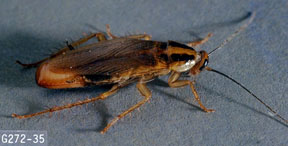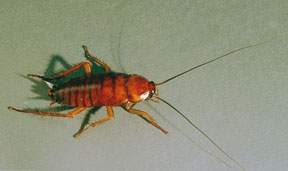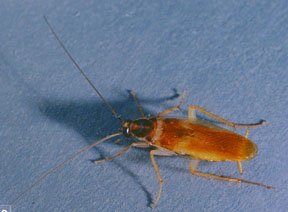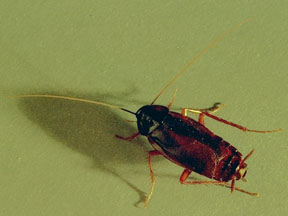by F.B. Peairs * (6/12)
Quick Facts…
- Cockroaches are associated with filth and unsanitary conditions.
- Known to carry disease organisms, they have not been tied to major disease outbreaks in the United States.
- Egg cases, nymphs and adults can be found in an infested area.
- Eliminate unnecessary sources of water, food and hiding places.
- Use traps, residual and non-residual insecticide sprays, and insecticide dusts to control or eliminate cockroaches.
Cockroaches are among the most undesirable insect intruders in the home. They are associated with filth and unsanitary conditions, although they occasionally invade the best-kept homes.
Though known to carry various disease organisms, cockroaches have not been associated with any major disease outbreaks in this country. The insects also produce a secretion that has a repulsive odor and can affect the flavor of food. Cockroaches can cause allergic reactions when sensitive people come into contact with contaminated food or house dust.
Biology
 |
 |
Figure 1: Brown-banded and American cockroach egg cases. |
|
Three cockroach life forms can be found in an infested area. The egg case is the size and shape of a bean and contains 10 to 20 cockroach eggs (Figure 1). The female may carry the eggs around until just before they hatch or, in some species, she may hide them in some protected area. As the eggs hatch, young cockroaches, or nymphs, emerge. Similar in shape and color to the adults, they are smaller and wingless. Their habitats and food preferences are the same as those of adults.
Cockroaches are active at night, so daytime observation is a good sign of a heavy infestation. They prefer protected areas, such as cracks and crevices, to rest and hide. Although cockroaches prefer starchy foods and meats, they will eat anything of plant or animal origin.
Common Species
There are more than 50 species of cockroaches in the United States. However, only five are likely to be found in Colorado.
The German cockroach is the most troublesome of all cockroaches. One of the smaller species, 1/2 inch when full grown, it is light brown with a pair of parallel brown bars between the head and the front of the wings (Figure 2). This species usually is associated with buildings where food is prepared or stored. It commonly migrates from infested areas into nearby dwellings or may be carried in on food containers. Favorite home habitats are warm, moist areas, such as kitchen sinks and appliances, bathroom sinks, and furnaces.
 |
Figure 2: German cockroach. (Photo from the K. Gray Image Collection, Oregon State University.) |
 |
Figure 3: American cockroach. (Photo from the K. Gray Image Collection, Oregon State University.) |
 |
Figure 4: Brown-banded cockroach. (Photo from the K. Gray Image Collection, Oregon State University.) |
 |
Figure 5: Oriental cockroach. (Photo from the K. Gray Image Collection, Oregon State University.) |
The American cockroach is the largest pest species found in Colorado — up to 2 inches long. It is mahogany-colored with a yellow margin around the head and around the shield behind the head (Figure 3). Although occasionally found in homes, the American cockroach more commonly is found in warm, moist areas of industrial or commercial buildings. Furnace or boiler rooms, sewers and heat tunnels are favored environments.
The brownbanded cockroach is similar in size and color to the German cockroach. It can be distinguished by the lack of brown bars on the shield in front of the wings and by the presence of two light bands across the wings and abdomen (Figure 4). It prefers a warmer, drier environment than the German cockroach and often is found in ceilings, light fixtures, furniture and appliances, especially televisions.
The oriental cockroach is intermediate in size between the German and the American cockroach and much darker. The adults have wings that do not reach the end of the abdomen (Figure 5). Many consider it the most repulsive common cockroach, primarily due to its strong odor. This species prefers cool, damp, dark areas. For this reason, it often is called a “water bug.” Common habitats include sewer drains, damp crawl spaces, basements and cellars. Infestations are most common in the spring and fall.
The wood cockroach prefers the outdoors and usually is found in wood piles, in dead trees and under bark. Attracted to lights, it occasionally enters homes and causes great alarm because it is so easily confused with pest cockroaches. The wood cockroach has a white band that runs around the head and the shield behind the head. Usually it does not survive or multiply indoors.
Cockroach Management
The three keys to effective cockroach management are prevention and sanitation, detection and chemical control. Satisfactory cockroach control will not be achieved unless each of these steps is followed.
Prevention and Sanitation
If cockroaches are migrating into a building or from another part of a building, install weather stripping and caulking where plumbing passes from infested areas into uninfested areas. Eliminate hiding places. For example, caulk cracks and crevices in dark, moist areas to discourage cockroaches. Inspect items brought into a building, especially food containers, furniture, appliances and clothing. The adults and young are easy to recognize. Because some cockroaches glue their egg cases to various surfaces, take particular care to look for the eggs.
Cockroaches need food, water and shelter. Water is particularly important, which is why infestations are most common in kitchens and bathrooms. Make any plumbing repairs and modifications needed to eliminate as much standing water as possible.
Do not allow food particles to accumulate in areas accessible to cockroaches. Common feeding areas include unwashed dishes, pet dishes, uncovered pet food containers, litter boxes, waste containers, and areas under refrigerators, stoves, sinks and furniture. Repair faulty plumbing and eliminate unnecessary sources of water. Reduce shelter for cockroaches; do not store unnecessary newspapers, boxes, rags and similar items that provide hiding places.
Detection
Detection is an important element of cockroach control. Cockroaches tend to concentrate in certain areas. Controls are more effective if they are targeted at these spots. Cockroach traps, small, open-ended boxes, contain an attractant and sticky substance that retains the insects once they enter. Use them to locate infestations and to determine when populations require additional treatment. Traps can be effective in catching the occasional invader, but they will not eliminate established colonies. Traps are most effective when placed against walls under sinks, in cabinets and in basement corners. If two nights pass without a capture, move the trap to another likely area.
Chemical Control
Cockroach insecticides include residual sprays, nonresidual sprays, dusts and baits. Use a combination for effective chemical cockroach control.
All cockroach insecticide labels contain important instructions and precautions to ensure effectiveness and to protect the safety of humans and pets. Read, understand and follow all label instructions when applying any residual spray, nonresidual spray, dust or bait.
Residual insecticide sprays leave a toxic deposit on surfaces and will kill cockroaches for a certain time period, usually two to four weeks. Apply to cracks and crevices where cockroaches hide and areas where they walk in search of food. Spray until the surface is wet, but avoid overapplications that puddle or run off.
Insecticides are poisons and should be treated as such. Used improperly, they can damage linoleum, carpets, drapes and paint. Various insecticides, under a variety of commercial names, are available for residual treatments against cockroaches. Some products are available to homeowners, while others are limited to licensed pest control operators. Residual insecticide treatments are generally effective, but cockroaches, especially the German, have developed insecticide resistance in many parts of the country.
Nonresidual insecticide sprays eliminate cockroaches only on contact. They will not eliminate an infestation but are quite helpful when used with residual treatments. Several short-lasting aerosol insecticides contain the active ingredients pyrethrins or resmethrin. They irritate cockroaches and can flush the pests out of their hiding places and force them into areas treated with a residual insecticide. This flushing action also is useful to determine whether or not cockroaches are present. Flushing agents, however, can drive them into previously uninfested parts of the building.
Insecticide dusts can penetrate cockroach hiding areas that other insecticides will not reach. When applied to dry locations, they have a longer useful life than residual sprays. Some dusts contain conventional insecticides, while others contain no organic chemicals.
Boric acid powder (also available as a residual spray), available under several commercial names, is relatively safe for humans, but do not expose children and pets to it. It can cause skin irritations if improperly handled, and it will harm house plants. Apply boric acid only to hiding places and runways. It is slow acting. Do not expect complete control for at least one week after application. Boric acid is among the best cockroach insecticides. Combined with its relative safety, this makes it a good choice for homeowners.
Other dusts are based on silica aerogel or diatomaceous earth. These are applied in the same manner as boric acid. They may not be as effective as boric acid because they are repellent to the cockroach. However, they can keep the pests out of certain areas, such as wall voids and attics. While boric acid is poisonous, silica aerogel and diatomaceous earth act by rubbing off the protective waxes that cover the cockroach’s body and cause death by dehydration.
Baits can be applied to areas that cannot be sprayed or dusted. They consist of an attractant, such as peanut butter or syrup, and a nonrepellent insecticide, such as boric acid. Baits are long lasting and are most effective when placed in small amounts in many locations. Most baits are available in child- and petproof containers. Baits are much more effective if they are the only food source available. Good sanitation is especially important for this type of control.
Professional Pest Control
If the situation is severe or it is unclear what to do, professional pest control services are available. These companies employ trained pest control operators and have access to insecticides and equipment that are not available to private individuals. Choose a company with the same care you use to select other services for the home.
Biological Control
Biological control uses one organism to control another. Where insecticides are undesirable or it is not necessary to eliminate cockroaches completely, consider a biological control program. Such programs have not been popular in the past because many find the biological control agent to be as distasteful as the cockroaches. Additionally, insecticide use would have to be minimized or eliminated, because the beneficial organism often is even more susceptible to insecticides than cockroaches.
Many kinds of organisms attack cockroaches: toads, bacteria, protozoa, beetles, mites and wasps. Parasitic wasps have had the most success. These are tiny insects, harmless to humans, that lay their eggs in the cockroach case. The eggs hatch into immature wasps that feed on the cockroach eggs. Wasps can reduce cockroach numbers dramatically and keep them at low levels, but they cannot completely eliminate the problem. Parasitic wasps have been used successfully in nonresidential office buildings and warehouses, but not in residential buildings where there is much less tolerance of cockroaches and other insects.
References
- Cornwell, P.B. 1968. The Cockroach. Volume I. Hutchinson, London, 391 pp.
- Cornwell, P.B. 1976. The Cockroach. Volume II. Hutchinson, London, 557 pp.
- Roth, L.M., and E.R. Willis. 1957. The medical and veterinary importance of cockroaches. Smithsonian Miscellaneous Collection 134(10): 1-147.
1Colorado State University Extension entomologist and professor, bioagricultural sciences and pest management. Artwork by Thomas J. Weissling. 7/95. Revised 6/12.
Colorado State University, U.S. Department of Agriculture and Colorado counties cooperating. Extension programs are available to all without discrimination. No endorsement of products mentioned is intended nor is criticism implied of products not mentioned.
Go to top of this page.





